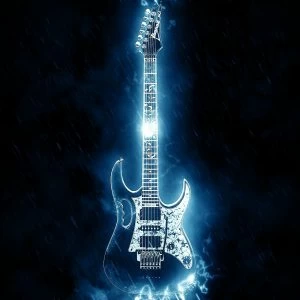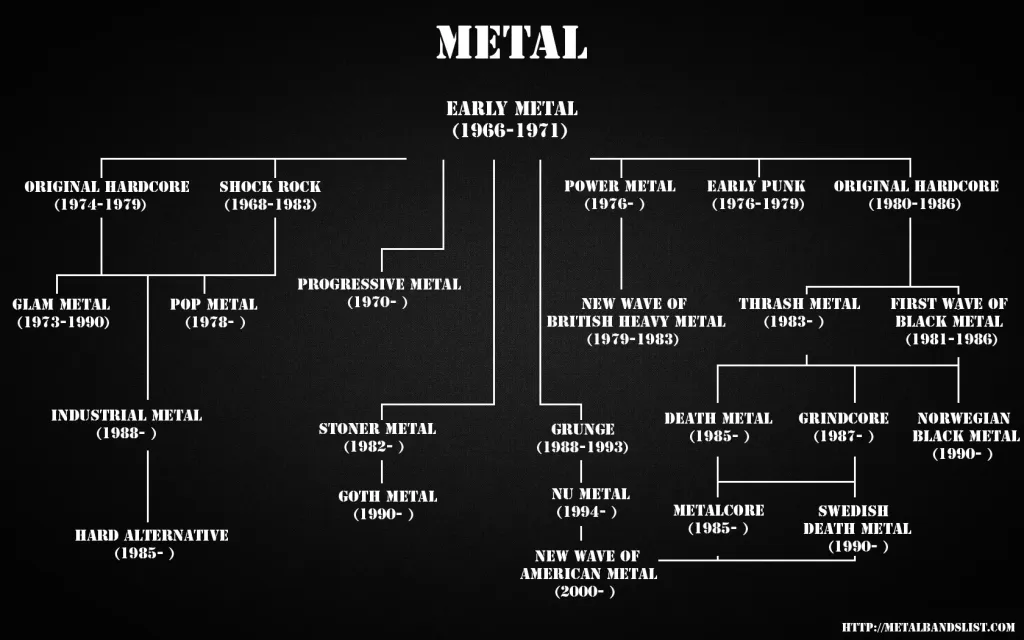
In the era of reggaeton and K-pop, metal music – or “heavy metal” – is still very much alive with its loyal, not necessarily long-haired fans all over the world. What is the secret of its phenomenon? Is there more to it than those yelling vocals, head-banging, fast drumming, and amplified ear-piercing guitar sounds? How did this genre come about and evolve throughout the years?
When searching for the origins of heavy metal, you’ll have to “rewind the tape” back to the “British Invasion” of the1960s, drop at a Link Wray, The Kinks, Townshend, Cream, Jeff Beck, or Jimi Hendrix gig, and see them experiment with a loud, rebel, and intense mix of blues and rock totally unheard of until then. In spite of the fierce criticism by those who derided it as “anti-music,” the new metal sound quickly caught the interest of the younger generation. For them, it became the music of a change that was shaping the world.
Metal music – key characteristics

There probably is no better definition of metal music than the one included in the 3rd verse of the song “Born to Be Wild” by Steppenwolf.
“I like smoke and lightnin’
Heavy metal thunder
Racing with the wind
And the feeling that I’m under”.
Indeed, heavy metal has the power of thunder. It stems from Hard Rock and the Blues and is characterized by:
- amplified guitar riffs and fast,
- bass playing alongside electric guitars,
- extended lead guitar solos,
- loud, energetic vocals almost to the point of screaming,
- dark lyrics often filled with aggression, doom, and rebellion,
- macabre iconography, black clothing, and the long hair of the musicians.
A particularly interesting aspect of metal music is also the aggressive use of drums to achieve a non-stop, loud beat. What may sound like a chaotic improvisation to an untrained ear actually requires exceptional coordination, precision, power, and dexterity.
For this very reason, it is the heavy metal drummers who – along with some virtuoso guitarists – have always received much of the credit. Dave Lombardo from Slayer, Lars Urlich from Metallica, Mike Portnoy from Dream Theater, or Chris Adler from Megadeth and their exceptional talent have been admired by generations of aspiring drummers and metal music fans.
The Pioneers of Heavy Metal

Even though the elements of heavy metal can be found in the music of many bands and artists from the 1960s and 1970s, it owes its popularity and development mainly to two great bands:
Led Zeppelin
Led Zeppelin, originally known as New Yardbirds, was an English band formed in London in 1968. Their debut album “Led Zeppelin,” released in 1969, was filled with new, experimental, heavier sounds, especially in the long blues-rock riffs by the band’s extraordinary guitarist Jimmy Page.
Led Zeppelin quickly became one of the most influential groups of the era and is considered one of the strongholds of metal music. Many of their songs (“Immigrant Song,” “Rock and Roll,” and “Stairway to Heaven” are among the classics of the genre.
Black Sabbath
If you consider yourself a true fan of Heavy Metal, this Birmingham-formed band with Ozzy Osborn as their first vocalist is most likely on your playlist. Their early music from the 1970s has been fundamental for the further development of the genre. Albums like “Black Sabbath,” “Paranoid” or “Master of Reality” quickly caught the audience’s attention not only with the new heavy sound but also with their obscure, horror-inspired lyrics.
Even though critics like Lester Bangs dismissed Black Sabbath’s first releases as “discordant jams with bass and guitar reeling like velocities speed freaks all over each other’s musical perimeters, yet never quite finding synch,” the popularity charts and the never-ending demand for live concerts told a different story.
Heavy metal – further development and top bands
The 1970s
With Led Zeppelin and Black Sabbath’s success, the heavier sound got firmly installed in the music world of the late seventies as more and more metal bands were born. Among them, those who cannot go unmentioned are:
| Deep Purple | Another British band that took heavy metal style as its own and rose to fame because of it. Many of their songs (e.g., “Smoke on the Water,” “Highway Star,” or “Child in Time”) with clear classic music inspirations have influenced entire generations of Heavy Metal fans.
Throughout time, Deep Purple has undergone multiple member changes, but its most classic lineup includes:
|
| Judas Priest | The band’s singer, Rob Halford, and his piercing falsetto make Judas Priest unique in its genre. Just a few chords will be enough to recognize their most successful and beloved songs, such as “’You’ve Got Another Thing Coming” (from the 1982 album “Screaming For Vengeance”, “Living After Midnight” (from “British Steel”), or “Breaking the Law” (also from “British Steel). |
| Iron Maiden | Another big name in metal music, Iron Maiden, has influenced countless bands since their formation in 1975 in London. They are particularly famous for their story-telling lyrics and powerful chorus, and their mascot – Eddie The Head – is one of the most recognizable icons of the genre, present in all of their concerts.
Controversy has always been a common aspect of heavy metal bands, and Iron Maiden was not free from it. However, the use of satanic imagery and suspicions of the Cult of Devil only added to the band’s popularity. If you want to get an idea of what Iron Maiden sounds like, make sure to listen to: “Run to the Hills,” “Fear of the Dark,” or “Hallowed be thy Name.” |
| Hell | Hell is a band from Derbyshire, England, that rose like a phoenix from the ashes of Race Against Time and Paralex. The authors of such masterpieces as “On Earth As It Is in Hell,” “Darkhangel” and “Faith Will Fall” are particularly known for their stage shows that included gothic references, corpse paint, exploding Bible, and other blasphemous elements. |
| AC/DC | The rise of heavy metal as a new music genre was not limited to England. The Australian band AC/DC was formed in 1973 and quickly flooded that side of the world with its energy, hard-hitting metal sounds with a touch of blues.
The distinctive, raspy voice of the iconic AC/DC vocalist Bon Scott can be heard in songs like “You Shook Me All Night Long” (their biggest radio hit), the classic “Highway to Hell,” or “Back in Black”. The latter ending with one of the best guitar riffs in the history of heavy metal. |
| Kiss | The early history of Heavy Metal wouldn’t be complete without the white-faced, flamboyant members of Kiss, an American band formed in 1973. The musicians hide under their stage personas: the Starchild, the Demon, the Spaceman, and the Catman, and their logo is among the most recognized in the world.
The studio versions of Kiss´s biggest hits, “Rock and Roll All Nite,” “Detroit Rock City,” and “Beth,” are impeccable, yet it is the live concert version that shows the true spirit of the band. |
The 1980s till Present

In the 1980s, metal music continued to develop, with several new bands emerging (Metallica, Pantera, Slayer, Megadeth, Dream Theater, and so on). What’s more, Heavy Metal as a genre started showing certain signs of evolution and diversification as well-defined sub-genres were born.
The most distinctive types of metal music from the eighties include:
Thrash Metal
With Metallica, Megadeth, Anthrax, and Slayer as its most famous representatives, Thrash Metal is a type of metal that evolved from the blend of punk and classic metal and is characterized mainly by fast and aggressive drum beats, guitar riffs with high complexity, and lyrics loaded with political references. “Battery” by Metallica is one of the greatest songs of this subgenre.
Doom Metal
Having emerged back in the seventies with Black Sabbath and their atmospheric, gothic-like music, Doom Metal continued developing in the 80s and 90s. Interestingly, many of the most emblematic representatives of this subgenre are Swedish bands, such as Candlemass, Draconian, and Katatonia, along with Electric Wizard and My Dying Bride (the latter two from England).
What’s distinctive about Doom Metal is the melancholic, often sad lyrics sung in growling vocals, slow tempo, powerful low-tuned guitar riffs, and solos. After the year 2000, this type of music has still been very much present with great hits like “Watching From A Distance” by Warning or “Swallow the Sun” by Empty Skies.
Alternative Metal
This type of metal music is heavily influenced by alternative rock, funk, rap, and industrial music and encompasses a wide array of bands that emerged mainly in the 90s (Tool, System of Down, Linkin Park, or Korn as some of the most distinctive ones). The common element that differentiates Alternative Metal from other subgenres is heavy, distorted, mid-paced guitars and melodic, sometimes harsh vocals.
Power Metal
Just listen to “Rebellion in Dreamland” by Gamma Ray, and you’ll know immediately what Power Metal is about. Uplifting, symphonic-like music and memorable lyrics with fantasy or mythology references clearly differentiate it from other types of metal. Here, the beat is faster, the chorus much stronger, and the overall atmosphere almost theatrical.
Progressive Metal
Take a pinch of classic Metal and mix it with a few drops of Progressive Rock. The fusion resulting from this experiment will surprise you with complex song structures and rhythm, technical proficiency, and frequent references to jazz and classical music. The Big 3 of this subgenre include Dream Theater, Tool, and Opeth. Make sure to check out “Lateralus” by Tool, as it is considered the best progressive metal song ever made.
Death Metal
Violence, gore, brutality, and references to satanism, science fiction, politics, and nature can be found in abundance in this extreme subgenre that emerged in the mid-1980s. Songs that are screamed or growled rather than sung, aggressive and fast drumming with notorious double kick and blast beat, low-tuned and complex guitar riffs – look out for these elements in the music of bands like Death, Morbid Angel, and Cannibal Corpse.
This is obviously NOT a complete list of all types of metal music as many of the subgenres divide and evolve even further, borrowing from different non-metal styles as well as from one another. Just take a look at the music tree below to get an idea of its complexity.
 Source:https://astralnoizeuk.com/2019/06/08/if-men-were-metal-genres-this-is-what-they-would-be-like/
Source:https://astralnoizeuk.com/2019/06/08/if-men-were-metal-genres-this-is-what-they-would-be-like/
How about today, over two decades after the turning of the century? Is heavy metal still relevant, or is it as aged as many of its former stars? As it turns out, not only is Heavy Metal very much alive, with loyal fans and festivals all over the world (Wacken Open Air being one of the most important), but it also keeps developing, as new bands like Bonginator, BRAT, Burner, Darvaza, or Dungeon Serpent emerge.

